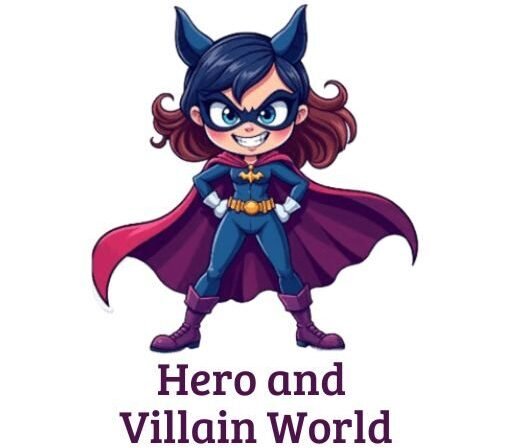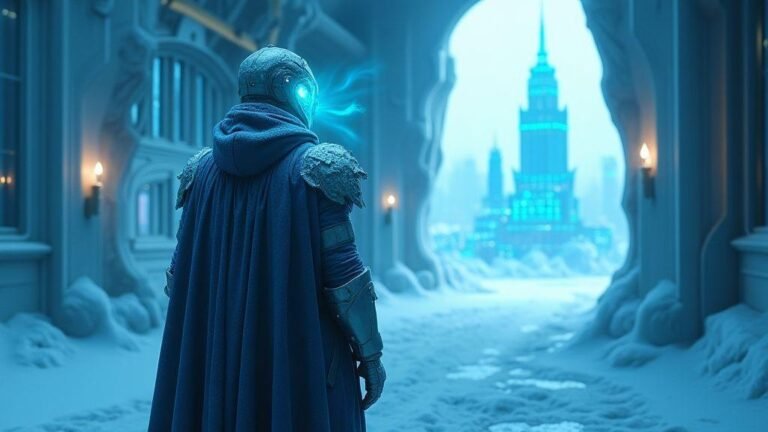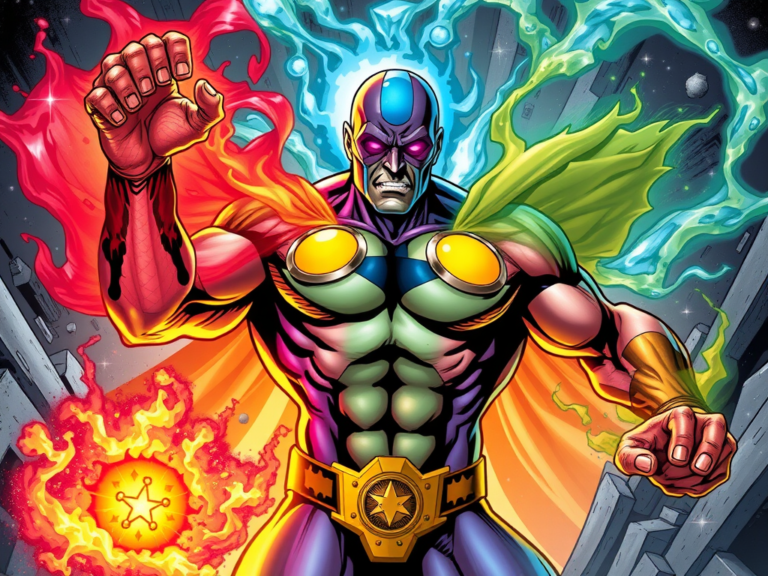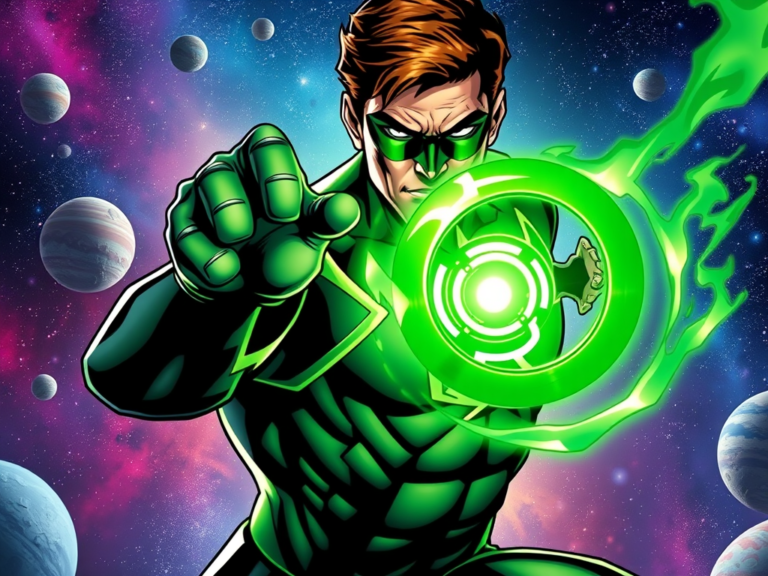Discover Green Arrow: His Story, Powers, and Legacy

Have you ever wondered what it takes to turn a billionaire playboy into a symbol of justice? Oliver Queen’s journey is one of the most compelling tales in the world of heroes.
From his privileged upbringing to his life-altering experience on a remote island, his story is a testament to resilience and redemption.
As the Green Arrow, Oliver Queen became more than just a vigilante. He stood as a protector of Star City, blending his archery skills with a deep sense of social justice. His dual identity allowed him to fight crime on the streets while also being a key member of the Justice League.
His life is a mix of tragedy and triumph, shaped by themes of survival and sacrifice. Whether it’s his iconic trick arrows or his complex relationships, Oliver’s legacy continues to inspire.
Dive into this information-packed journey to uncover what makes him one of DC’s most engaging characters.
Who Is Green Arrow?
Behind the mask of Star City’s protector lies a man with a story as complex as his mission. Oliver Jonas Queen, the billionaire CEO of Queen Industries, is a character defined by his dual identity. By day, he’s a powerful businessman; by night, he’s a vigilante fighting for justice.
Oliver’s journey began with privilege. As a wealthy playboy, he lived a life of excess. But his time stranded on a remote island changed everything. It was there he honed his archery skills and crafted his iconic bow, setting the stage for his transformation into a hero.
Unlike Batman, Oliver’s mission is deeply rooted in social justice. He tackles issues like corruption, inequality, and environmental concerns. His methods are direct, often acting as judge, jury, and executioner. This sets him apart from other heroes in the Justice League.
His signature look is instantly recognizable: a goatee, a hooded costume, and a quiver full of specialized arrows. These elements not only define his appearance but also reflect his resourcefulness and determination.
Oliver’s personality is as complex as his mission. He’s passionate, idealistic, and often hot-headed. His flaws make him relatable, reminding us that even heroes are human. This character depth is what makes Oliver Queen a compelling figure in the world of comics.
The Creation of an Emerald Archer
What inspired the creation of one of DC’s most iconic vigilantes? The story of Oliver Queen’s alter ego begins in the Golden Age of comics, a time when heroes were larger than life.
In 1941, creators Mort Weisinger and George Papp introduced this character in More Fun Comics #73, blending the charm of Robin Hood with the grit of Batman.
Weisinger and Papp envisioned a hero who stood out. They drew inspiration from Robin Hood, giving him the nickname “Emerald Archer.”
This hybrid concept combined medieval archery with modern crime-fighting, creating a unique character that resonated with readers. The early stories had a campy tone, fitting the style of the time.
One of the most notable additions to the series was Speedy, introduced in the same year. As the first sidekick, Speedy brought a youthful energy to the stories, much like Robin did for Batman. This dynamic duo quickly became a fan favorite.
George Papp’s visual design played a crucial role in shaping the hero’s appearance. From the iconic hooded costume to the trick arrows, Papp’s creativity brought the character to life.
Over the years, the design evolved, reflecting the changing tastes of readers and the darker tone of modern comics.
The journey from campy beginnings to modern grit highlights the enduring appeal of this hero. Whether you’re a longtime fan or new to the story, the origins of the Emerald Archer are a fascinating chapter in comic book history.
#1 New York Times best-selling writer Brad Meltzer (Identity Crisis) and acclaimed artist Phil Hester (Green Arrow: Quiver) take Oliver Queen from the grave and onto the road for an adventure of past, present, and future!
Oliver Queen has recently returned from the dead and like all iconic ghosts he’s looking to get closure on some unfinished business. Packing his bags and hitting the road, Green Arrow will travel cross country with his old apprentice, now known as Arsenal, in search of lost treasures.
Oliver Queen’s Transformation
Oliver Queen’s journey from reckless billionaire to hero is a tale of survival and redemption. Before his transformation, he lived a life of excess, throwing lavish parties and indulging in every luxury. But fate had other plans for this man of privilege.
During a party on his yacht, sabotage led to an explosion that left him stranded on Starfish Island. This event marked the death of his old life and the beginning of a new way of thinking. Alone and desperate, Oliver had to rely on his wits to survive.
On the island, he forged a bow from scraps and trained relentlessly to master archery. This grueling year of isolation wasn’t just about physical survival—it was a moral awakening. Oliver began to see the world differently, realizing the impact of his past actions.
This experience left permanent psychological changes. He became more responsible, driven by a newfound purpose to protect others. The island didn’t just shape his skills; it forged his identity as a hero.
Oliver Queen’s transformation is a testament to the power of resilience and redemption. His story reminds us that even the most unlikely individuals can rise to greatness.
The Island That Forged a Hero
Starfish Island wasn’t just a setting—it was the crucible that forged a hero. For Oliver Queen, this remote location became a place of transformation, where he faced challenges that tested his resolve and reshaped his purpose.
It was here that the man of privilege became the protector of justice.
Key locations on the island played a pivotal role in his journey. From dense jungles to rocky cliffs, each area presented unique obstacles. These environments forced Oliver to adapt, honing his survival skills and sharpening his instincts. The island wasn’t just a backdrop; it was a character in its own right.

During his time on the island, Oliver encountered pirates and drug runners. These confrontations weren’t just physical battles—they were moral tests. He had to decide how far he was willing to go to survive and protect others. These experiences shaped his sense of justice and deepened his commitment to fighting crime.
It was also on the island that Oliver developed his signature combat style. Using scraps and natural resources, he crafted his first trick arrows.
These ingenious tools became a hallmark of his arsenal, showcasing his resourcefulness and creativity. The island was his workshop, where he turned adversity into innovation.
Symbolically, the island represented both rebirth and death. It was a place where Oliver’s old life ended, and his new identity began.
This duality is echoed in later storylines, such as “Quiver,” where the island’s influence continues to shape his legacy. It’s a reminder that even in the darkest times, there’s potential for renewal.
Starfish Island’s impact on Oliver Queen is undeniable. It was here that he became more than just a man—he became a hero.
His journey on the island is a testament to the power of resilience and the enduring strength of the human spirit. It’s a story that continues to inspire, reminding us that even in the harshest world, we can rise to greatness.
Green Arrow’s Arsenal and Abilities
What makes a hero truly stand out? It’s not just their story, but the tools and skills they wield. Oliver Queen, also known as the Emerald Archer, is a prime example.
His abilities and arsenal are as legendary as his journey. From his unmatched archery skills to his innovative trick arrows, he’s a force to be reckoned with.
Master Archery Skills
Oliver’s archery skills are nothing short of Olympic-level. With a bow that has a 187lbs draw weight, he can hit targets with pinpoint accuracy. His precision is unmatched, whether he’s taking down enemies or disarming traps.
This mastery didn’t come overnight—it was honed during his time stranded on an island, where he taught himself to survive.
Peak Human Conditioning
Beyond archery, Oliver’s physical conditioning is extraordinary. He’s a martial artist trained in multiple disciplines, including boxing, judo, and kickboxing.
His strength and endurance allow him to patrol for hours, making him a relentless protector of Star City. His rigorous training regimen ensures he’s always at the top of his game.
Specialty Trick Arrows
One of Oliver’s most iconic features is his collection of trick arrows. With over 30 types, including kryptonite, hacking, and even boxing glove arrows, he’s always prepared for any situation.
These arrows are more than just tools—they’re a testament to his creativity and resourcefulness. His quiver system has also seen technological upgrades, enhancing its functionality and making it a key part of his crime-fighting arsenal.
Oliver Queen’s abilities make him a unique hero in the DC Universe. Whether it’s his mastery of the bow, his physical prowess, or his innovative arrows, he’s a symbol of resilience and ingenuity. To learn more about his skills, check out this detailed breakdown of Green Arrow’s abilities.
Vulnerabilities and Limitations
Every hero has their weaknesses, and Oliver Queen is no exception. Despite his incredible skills and determination, he faces challenges that remind us even the greatest heroes are human. His journey is as much about overcoming limitations as it is about fighting for justice.
Unlike many in the Justice League, Oliver doesn’t have superpowers. He relies on his training, intelligence, and technology to protect Star City.
This makes him vulnerable when facing metahumans or advanced threats. His physical limits are a constant reminder that he’s just a man in a world of gods and monsters.
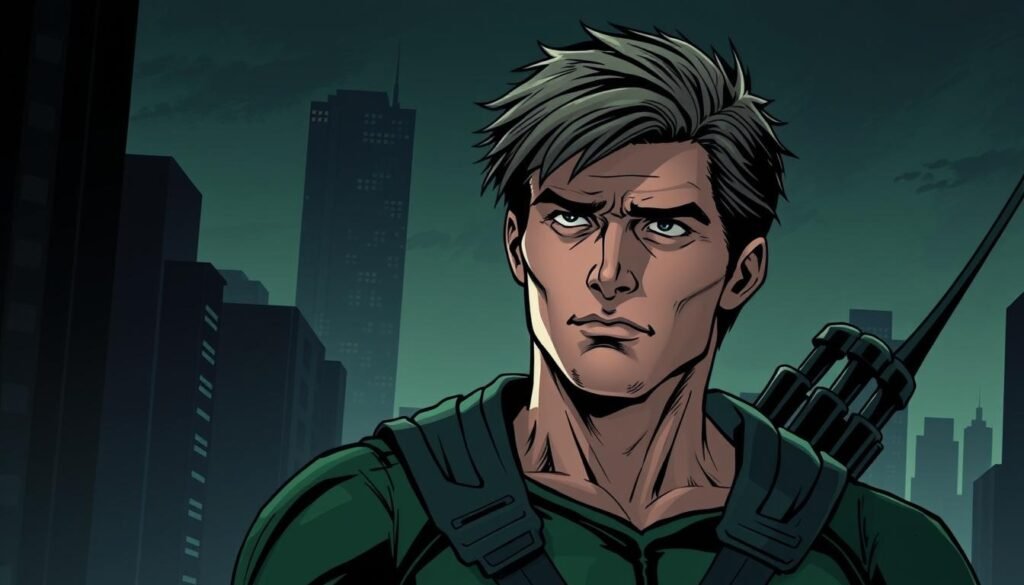
One of his biggest challenges is managing his arsenal. Running out of arrows in the middle of a fight can be a death sentence.
Logistics and supply issues often force him to improvise, testing his resourcefulness. This limitation keeps him grounded, making his victories even more impressive.
Oliver’s time on the island left deep psychological scars. The isolation and trauma shaped him but also created vulnerabilities.
His struggles with substance abuse and trust issues show that even heroes battle inner demons. These flaws make him relatable, reminding us that strength isn’t just physical.
Financially, Oliver depends on Queen Industries to fund his mission. Without it, his ability to protect Star City would be severely limited.
This dependency adds another layer of complexity to his role as a hero. It’s a reminder that even the most dedicated individuals need support from their group.
Ethically, Oliver’s moral code prevents him from killing, even when it might seem necessary. This creates conflicts in high-stakes situations, forcing him to find alternative solutions. His commitment to justice often comes at a personal cost, highlighting the sacrifices heroes make.
Oliver Queen’s vulnerabilities are what make him a compelling character. They show that being a hero isn’t about perfection—it’s about resilience. His story reminds us that even in the face of limitations, we can rise to the challenge and make a difference.
- Incredibly detailed 7” scale figure based off the DC Multiverse
- Designed with Ultra Articulation with up to 22 moving parts for full range of posing and play
- Green Arrow is based on his look from Injustice 2 comic
Star City’s Protector
Star City’s streets have seen both chaos and redemption. As its protector, Oliver Queen fights tirelessly to keep the city safe. From the shadows of the Glades to the bustling downtown, his presence is felt in every corner.
Key locations like the Arrowcave, hidden beneath the Verdant nightclub, serve as his headquarters. This building is more than just a base—it’s a symbol of his commitment to justice. Other hotspots, such as the Glades, are frequent targets of his vigilantism.
Oliver’s urban crime-fighting tactics are both strategic and relentless. He uses his archery skills to disarm criminals and his intelligence to dismantle criminal networks.
His partnership with Lt. Jim Cameron of the Star City Police Department strengthens his efforts, bridging the gap between vigilante and law enforcement.
Star City’s history is marked by cycles of destruction and rebuilding. Events like the Undertaking and the Siege left the city in ruins, but each time, it rose stronger. These cycles reflect the resilience of its people and the dedication of its protector.
Gentrification has also played a role in shaping Star City. The rebranding from Starling City to Star City symbolized a new era of growth and revitalization. However, it also brought challenges, as Oliver worked to ensure that progress didn’t leave the vulnerable behind.
| Location | Significance |
|---|---|
| Arrowcave | Headquarters and training ground |
| The Glades | Crime hotspot and focus of revitalization |
| Verdant Nightclub | Front for the Arrowcave |
Oliver Queen’s mission in Star City is more than just fighting crime. It’s about rebuilding trust, fostering hope, and ensuring that the city thrives. His story is a testament to the power of resilience and the enduring spirit of a protector.
Green Arrow’s Iconic Relationships
What defines a hero beyond their powers? Often, it’s the relationships they build along the way. For Oliver Queen, these bonds were as crucial as his archery skills. From love to mentorship, the people in his life shaped his journey and legacy.

Black Canary: Love and Crimefighting
Dinah Lance, also known as Black Canary, was more than just a partner in crimefighting. Their relationship was a mix of passion and challenges.
Married in 2007, their union symbolized a deep connection, but it wasn’t without struggles. Infidelity and separation tested their bond, yet they remained a formidable team.
Their partnership extended beyond personal ties. Together, they tackled some of Star City’s toughest threats. Dinah’s martial arts skills complemented Oliver’s archery, making them an unstoppable duo. Despite the ups and downs, their love story remains a cornerstone of Oliver’s life.
Roy Harper: From Sidekick to Equal
Roy Harper’s journey with Oliver began as a troubled teen. Adopted after his parents’ death, Roy became Oliver’s protégé, known as Speedy. Over time, he evolved into Arsenal, a hero in his own right. Their relationship was marked by mentorship, conflict, and mutual respect.
Roy’s struggles with addiction and identity often put him at odds with Oliver. Yet, these challenges only strengthened their bond. By the end, Roy stood as an equal, proving that the student had become the master. Their story is a testament to the power of family and growth.
| Relationship | Key Moments |
|---|---|
| Black Canary | Marriage in 2007, crimefighting partnership |
| Roy Harper | From Speedy to Arsenal, mentorship and growth |
| Connor Hawke | Biological son, rocky start to closeness |
| Shado | Key ally during fugitive period |
Oliver Queen’s legacy isn’t just about his skills or victories. It’s about the people who stood by him, shaping his path and inspiring his mission. These relationships remind us that even heroes need a team to truly make a difference.
Justice League Years
What does it mean to stand shoulder-to-shoulder with the world’s greatest heroes? For Oliver Queen, joining the Justice League was both an honor and a challenge. As a founding member of the Justice League of America, he brought a unique perspective to the team.
Oliver’s role in the League wasn’t just about fighting crime—it was about bridging the gap between street-level justice and global threats. His archery skills and tactical mind made him a valuable asset.
But his journey wasn’t without friction. His clashes with Batman, especially under Denny O’Neil’s writing, highlighted their contrasting approaches to justice.
One of Oliver’s defining moments came during the “Cry for Justice” event. Here, he took a stand against the League’s passive stance, pushing for a more proactive approach.
This decision showcased his leadership and willingness to challenge the status quo, even if it meant alienating his fellow heroes.
Oliver’s political debates with Hal Jordan, another founding member, further defined his role. Their ideological clashes often mirrored real-world issues, adding depth to their dynamic. These debates weren’t just about strategy—they were about the soul of the Justice League.
During Crisis events, Oliver’s leadership shone. He stepped up when the team needed direction, proving that even a man without superpowers could inspire greatness. His contrast with other billionaire heroes, like Batman, highlighted his focus on social justice and equality.
In the Rebirth era, Oliver continues to prove his worth. His mission isn’t just about fighting villains—it’s about earning his place among the world’s greatest protectors. His story reminds us that true heroism isn’t about power; it’s about purpose.
Notable Villains and Rivals
What makes a hero’s journey unforgettable? Often, it’s the villains they face. Oliver Queen’s path as Star City’s protector was shaped by his battles with some of the most dangerous adversaries in the DC Universe.
From archery rivals to political masterminds, these foes tested his skills, morals, and resilience.

One of Oliver’s most iconic enemies is Malcolm Merlyn, also known as the Dark Archer. A former mentor turned bitter rival, Merlyn’s archery skills rival Oliver’s own. Their confrontations are not just physical—they’re deeply personal, often driven by revenge and betrayal.
Merlyn’s presence reminds us that even the closest bonds can turn into battles for survival.
Count Vertigo is another formidable foe. With his neurological weapons, he disrupts balance and perception, making him a challenging adversary.
His tactics force Oliver to rely on more than just his bow, testing his adaptability and resourcefulness. Vertigo’s unpredictability adds a layer of danger to every encounter.
Komodo, a former protégé of Oliver’s father, brings a personal connection to their rivalry. His quest for vengeance against the Queen family makes him a relentless and emotional threat. Komodo’s presence highlights the impact of Oliver’s past on his present struggles.
Onomatopoeia, a serial killer targeting vigilantes, is perhaps the most enigmatic of Oliver’s enemies. His sound-based gimmick and relentless pursuit make him a constant danger.
Onomatopoeia’s unpredictability keeps Oliver on edge, reminding him that not all threats are straightforward.
Oliver’s adversaries aren’t just individuals—they’re part of a larger group of organized crime and political antagonists. Figures like Amanda Waller and Maxwell Lord represent the systemic challenges Oliver faces.
Their manipulation and influence test his commitment to justice, proving that some battles are fought off the streets.
These villains and rivals are more than just obstacles—they’re a testament to Oliver’s growth as a hero. Each encounter shapes his legacy, reminding us that even the greatest heroes are defined by the others they face.
Their stories are a crucial part of what makes Oliver Queen’s journey so compelling.
Green Arrow Across Media
How has one hero’s journey inspired countless adaptations across different media? Oliver Queen’s story has transcended comic books, finding its way into live-action shows, animated series, and even video games.
His appearances across platforms have cemented his place as one of DC’s most versatile heroes.
Live Action Portrayals
Stephen Amell’s portrayal in *Arrow* (2012-2020) brought Oliver Queen to life in a gritty, modern way.
The show redefined the character, focusing on his transformation from a playboy to a vigilante. It also introduced the Arrowverse, with crossovers featuring *The Flash* and *Legends of Tomorrow*.
Before Amell, Justin Hartley played the role in *Smallville*. As a founding member of the Justice League in the series, Hartley’s Oliver Queen was a key figure in the show’s later seasons. His relationship with Chloe Sullivan added depth to the character.
Animated Appearances
Green Arrow has also made his mark in animation. In *Justice League Unlimited*, he was a vital part of the team, often clashing with Batman over their differing ideologies. His wit and archery skills made him a fan favorite.
The *Young Justice* series further expanded his role. Here, he mentored younger heroes, showcasing his leadership and commitment to justice. These appearances highlight his adaptability across different storytelling formats.
| Media | Key Details |
|---|---|
| *Arrow* (2012-2020) | Stephen Amell’s portrayal, Arrowverse crossovers |
| *Smallville* | Justin Hartley’s role, Justice League founding member |
| *Justice League Unlimited* | Animated series, team dynamics |
| *Young Justice* | Mentorship, leadership role |
Video games like *Injustice 2* have also featured Green Arrow. His moveset emphasizes his archery skills, making him a unique fighter in the game. With upcoming DCU projects, his legacy continues to grow, proving that this hero’s story is far from over.
The Emerald Archer’s Cultural Impact
What makes a hero resonate beyond the pages of a comic book? For Oliver Queen, it’s his ability to tackle real-world issues while staying true to his character. From groundbreaking storylines to diverse representation, his journey has left an indelible mark on pop culture.
One of the most significant moments came in 1971, when Speedy, Oliver’s sidekick, became the first mainstream character to struggle with drug addiction.
This storyline broke barriers, showing that even heroes face personal battles. It was a bold move that paved the way for more mature storytelling in comics.
Oliver’s commitment to justice extends beyond crime-fighting. His stories often address social issues like inequality, corruption, and environmental concerns. This focus on real-world problems makes him relatable and relevant, even decades after his creation.
Representation has also been a cornerstone of his legacy. In 2001, Mia Dearden, the new Speedy, was introduced as an HIV-positive character. Her story highlighted LGBTQ+ representation, showcasing the world of comics as a space for inclusivity and diversity.
- Influence on street-level superhero genre: Oliver’s grounded, realistic approach inspired a new wave of heroes focused on personal struggles.
- Political commentary legacy: His stories often mirror real-world debates, making him a voice for change.
- Fan convention culture: His popularity has fueled fan events, where enthusiasts celebrate his journey and impact.
Oliver Queen’s cultural impact is a testament to the power of storytelling. By addressing real issues and embracing diversity, he has become more than just a character—he’s a symbol of hope and progress for others.
Key Story Arcs Every Fan Should Know
What are the must-read stories that every fan of Oliver Queen should explore? From gritty reboots to emotional resurrections, these arcs define his journey as a hero. Each one offers a unique glimpse into his life, struggles, and triumphs.
One of the most impactful arcs is *The Longbow Hunters*. Published in 1987, this series introduced mature themes, focusing on Oliver’s violent methods and the toll they took on his relationships. It marked a turning point in his time as a vigilante, showcasing his darker side.
Another essential read is *Quiver*, which brought Oliver back from the death. This arc explored his resurrection and the role of his son, Connor Hawke, in reuniting his soul. It added emotional depth to his story, making it a fan favorite.
The *New 52* reboot also stands out. Volumes like *Year One* and *The Kill Machine* redefined Oliver’s origins and struggles. These stories provided a fresh starting point for new readers while staying true to his core character.
In the *Rebirth* era, arcs like *The Death & Life of Oliver Queen* fixed continuity issues and reintroduced him post-crisis. These stories highlighted his resilience and commitment to justice, proving that even after death, he could rise again.
Finally, *Dark Crisis* crossovers showcased Oliver’s role in larger DC events. These arcs explored themes of redemption and sacrifice, cementing his place as a key part of the DC Universe.
These story arcs are more than just comics—they’re a testament to Oliver Queen’s enduring legacy. Whether you’re a longtime fan or new to his journey, these tales are essential for understanding what makes him one of DC’s most compelling heroes.
Green Arrow’s Legacy in DC Comics
What defines a hero’s lasting impact on the world? For Oliver Queen, it’s the enduring influence he’s had on the DC Universe. His legacy extends beyond his own story, inspiring a new generation of heroes and shaping the future of justice.
Oliver’s legacy is most evident in the Arrow family. Characters like Red Arrow, Artemis, and Emiko Queen have carried on his mission, each bringing their unique skills and perspectives. This family of heroes ensures that his ideals continue to thrive, even in his absence.
Multiverse variants of Oliver Queen also highlight his versatility. From Earth-2’s historical versions to Future State iterations, these alternate versions explore different facets of his character.
They show how his story can adapt to new challenges and settings, keeping him relevant across timelines.
Oliver’s influence is particularly strong on the Young Justice generation. His mentorship and leadership have inspired younger heroes to take up the mantle of justice. This connection ensures that his legacy lives on in the hearts and actions of those he’s guided.
“A hero’s true legacy is not in what they achieve, but in who they inspire.”
In the Justice League, Oliver’s role has been permanent and pivotal. His unique approach to justice and his ability to bridge gaps between street-level and global threats make him an indispensable member.
His presence in the League cements his place as one of DC’s most important heroes.
| Legacy Character | Role |
|---|---|
| Red Arrow | Protégé and successor |
| Artemis | Skilled archer and ally |
| Emiko Queen | Biological sister and partner |
Oliver Queen’s legacy is a testament to the power of one character to inspire and shape an entire universe. His story continues to resonate, proving that true heroism is about more than just individual achievements—it’s about the lives you touch and the world you leave behind.
Product details
Fabric typeSolid colors: 100% Cotton; Heather Grey: 90% Cotton, 10% Polyester; Dark Heather and Heather Blue: 50% Cotton, 50% Polyester; OR Dark Heather, Heather Blue and All Other Heathers: 65% Polyester, 35% Cotton; Girls’ Heathers: 60% Cotton, 40% Polyester
Care instructionsMachine Wash
OriginImported
Closure typePull On
Conclusion
Oliver Queen’s story is a testament to resilience and redemption, inspiring countless fans. From his early days as a billionaire playboy to his ultimate sacrifice as a hero, his journey has left an indelible mark on the world of comics.
His commitment to justice and his ability to inspire others make him a timeless figure in the DC Universe.
As the Emerald Archer, Oliver’s legacy continues to shape the way we view heroes. His influence extends beyond his own story, inspiring a new generation of protectors. The Arrow Family, including characters like Mia Queen and Black Canary, ensures his ideals live on.
Looking ahead, future comic developments promise to explore new dimensions of his legacy. Whether it’s through reboots or spin-offs, Oliver’s story remains a cornerstone of the DC Universe. Dive deeper into his world and discover the enduring impact of this iconic hero.
Got questions? Check out our FAQ section for more insights into Oliver Queen’s journey and legacy.
FAQ
Q: Who created the Emerald Archer?
A: Mort Weisinger and George Papp brought the character to life during the Golden Age of comics.
Q: What happened to Oliver Queen on the island?
A: He faced extreme challenges that transformed him from a wealthy playboy into a skilled vigilante.
Q: What are Green Arrow’s main abilities?
A: He’s a master archer, has peak human conditioning, and uses specialty trick arrows to fight crime.
Q: Who are Green Arrow’s closest allies?
A: Black Canary is his romantic and crimefighting partner, while Roy Harper evolved from sidekick to equal.
Q: What role does he play in the Justice League?
A: He’s a key member, using his skills and moral compass to protect the world alongside other heroes.
Q: Who are some of his notable villains?
A: He’s faced foes like Merlyn, Count Vertigo, and the ruthless Deathstroke.
Q: How has Green Arrow appeared in other media?
A: He’s been portrayed in live-action shows like *Arrow* and featured in animated series like *Justice League Unlimited*.
Q: What is his cultural impact?
A: He’s become a symbol of justice, resilience, and the fight against corruption in DC Comics and beyond.
Q: What are some must-read Green Arrow story arcs?
A: *The Longbow Hunters* and *Quiver* are essential reads for fans of the character.
Q: How has Green Arrow influenced DC Comics?
A: His legacy includes inspiring new heroes and shaping the moral landscape of the DC Universe.
